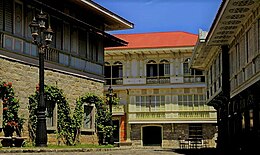
Back عمارة الفلبين Arabic Arquitectura de Filipinas Spanish ფილიპინების არქიტექტურა Georgian Arkitektura ng Pilipinas Tagalog

| This article is part of a series on the |
| Culture of the Philippines |
|---|
 |
| Society |
| Arts and Literature |
| History and Tradition |
| Symbols |
|
Philippines portal |
The architecture of the Philippines reflects the historical and cultural traditions in the country. Most prominent historic structures in the archipelago are influenced by Austronesian and American architectures.
During three hundred thirty years of Spanish colonization, the Philippine architecture was dominated by the Spanish influences. The Augustinian friars, along with other religious orders, built many grand churches and cathedrals all over the Philippine Islands. During this period the traditional Filipino Bahay na bató (Filipino for "house of stone") style for the large houses emerged. These were large houses built of stone and wood combining Filipino, Spanish and Chinese style elements.
After the Philippines was ceded to the United States as a consequence of the Spanish–American War in 1898, the architecture of the Philippines was influenced by American aesthetics. In this period, the plan for the modern City of Manila was designed, with many neoclassical architecture and art deco buildings by famous American and Filipino architects. During World War II, large portions of Intramuros and Manila were destroyed; many heritage districts in the provinces were burned down by the Japanese before the end of the war. In the reconstruction period after the Second World War, many of the destroyed buildings were rebuilt, however, a majority of heritage structures, especially in the provinces, were lost and never rebuilt. Most of the structures that were lost are considered focal properties of former heritage towns.
In the late 20th century, modern architecture with straight lines and functional aspects was introduced, particularly in the Brutalist architecture that characterized government-built structures done in the Marcos period. During this period many of the older structures fell into decay due to the imposition of martial law.[citation needed] After the return of democracy in 1986, a new age of Philippine architecture came into focus through modernism. Early in the 21st century, a revival of the respect for the traditional Filipino elements in the architecture returned.
There have been proposals to establish a policy where each municipality and city will have an ordinance mandating all constructions and reconstructions within such territory to be inclined with the municipality or city's architecture and landscaping styles to preserve and conserve the country's dying heritage sites, which have been demolished one at a time in a fast pace due to urbanization, culturally-irresponsible development, and lack of towns-cape architectural vision.
The proposal advocates for the usage and reinterpretations of indigenous, colonial, and modern architectural and landscaping styles that are prevalent or used to be prevalent in a given city or municipality. The proposal aims to foster a renaissance in Philippine landscaping and townscaping, especially in rural areas which can easily be transformed into new architectural heritage towns within a 50-year time frame. Unfortunately, many Philippine-based architecture and engineering experts lack the sense of preserving heritage townscapes, such as the case in Manila, where business proposals to construct structures that are not inclined with Manila's architectural styles have been continuously accepted and constructed by such experts, effectively destroying Manila's architectural townscape one building at a time.[citation needed] Only the city of Vigan has an ordinance on architectural policy, which led to its declaration as a UNESCO World Heritage Site in 1999 and awarding of various recognition for the conservation and preservation of its unique architectural and landscaping styles.
To help establish a national architectural policy, bills to establish a Department of Culture were filed in the Senate and House of Representatives in 2016.[1][2]
- ^ Luengo, Pedro (2012). Intramuros: Arquitectura en Manila, 1739–1762 (in Spanish). Madrid: Fundacion Universitaria Española.
- ^ Blair, Emma Helen; Robertson, James Alexander (eds.). The Philippine Islands, 1493–1803. Vol. 3. Cleveland: Arthur H. Clark Co. – via gutenberg.org.